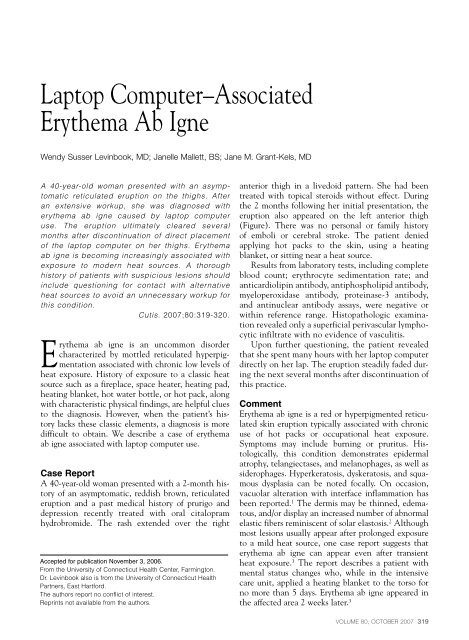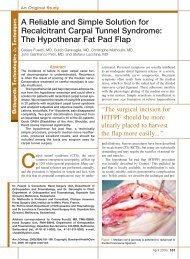Laptop Computer–Associated Erythema Ab Igne - Cardiology News
Laptop Computer–Associated Erythema Ab Igne - Cardiology News
Laptop Computer–Associated Erythema Ab Igne - Cardiology News
You also want an ePaper? Increase the reach of your titles
YUMPU automatically turns print PDFs into web optimized ePapers that Google loves.
<strong>Laptop</strong> <strong>Computer–Associated</strong><br />
<strong>Erythema</strong> <strong>Ab</strong> <strong>Igne</strong><br />
Wendy Susser Levinbook, MD; Janelle Mallett, BS; Jane M. Grant-Kels, MD<br />
A 40-year-old woman presented with an asymptomatic<br />
reticulated eruption on the thighs. After<br />
an extensive workup, she was diagnosed with<br />
erythema ab igne caused by laptop computer<br />
use. The eruption ultimately cleared several<br />
months after discontinuation of direct placement<br />
of the laptop computer on her thighs. <strong>Erythema</strong><br />
ab igne is becoming increasingly associated with<br />
exposure to modern heat sources. A thorough<br />
history of patients with suspicious lesions should<br />
include questioning for contact with alternative<br />
heat sources to avoid an unnecessary workup for<br />
this condition.<br />
Cutis. 2007;80:319-320.<br />
<strong>Erythema</strong> ab igne is an uncommon disorder<br />
characterized by mottled reticulated hyperpigmentation<br />
associated with chronic low levels of<br />
heat exposure. History of exposure to a classic heat<br />
source such as a fireplace, space heater, heating pad,<br />
heating blanket, hot water bottle, or hot pack, along<br />
with characteristic physical findings, are helpful clues<br />
to the diagnosis. However, when the patient’s history<br />
lacks these classic elements, a diagnosis is more<br />
difficult to obtain. We describe a case of erythema<br />
ab igne associated with laptop computer use.<br />
Case Report<br />
A 40-year-old woman presented with a 2-month history<br />
of an asymptomatic, reddish brown, reticulated<br />
eruption and a past medical history of prurigo and<br />
depression recently treated with oral citalopram<br />
hydrobromide. The rash extended over the right<br />
Accepted for publication November 3, 2006.<br />
From the University of Connecticut Health Center, Farmington.<br />
Dr. Levinbook also is from the University of Connecticut Health<br />
Partners, East Hartford.<br />
The authors report no conflict of interest.<br />
Reprints not available from the authors.<br />
anterior thigh in a livedoid pattern. She had been<br />
treated with topical steroids without effect. During<br />
the 2 months following her initial presentation, the<br />
eruption also appeared on the left anterior thigh<br />
(Figure). There was no personal or family history<br />
of emboli or cerebral stroke. The patient denied<br />
applying hot packs to the skin, using a heating<br />
blanket, or sitting near a heat source.<br />
Results from laboratory tests, including complete<br />
blood count; erythrocyte sedimentation rate; and<br />
anticardiolipin antibody, antiphospholipid antibody,<br />
myeloperoxidase antibody, proteinase-3 antibody,<br />
and antinuclear antibody assays, were negative or<br />
within reference range. Histopathologic examination<br />
revealed only a superficial perivascular lymphocytic<br />
infiltrate with no evidence of vasculitis.<br />
Upon further questioning, the patient revealed<br />
that she spent many hours with her laptop computer<br />
directly on her lap. The eruption steadily faded during<br />
the next several months after discontinuation of<br />
this practice.<br />
Comment<br />
<strong>Erythema</strong> ab igne is a red or hyperpigmented reticulated<br />
skin eruption typically associated with chronic<br />
use of hot packs or occupational heat exposure.<br />
Symptoms may include burning or pruritus. Histologically,<br />
this condition demonstrates epidermal<br />
atrophy, telangiectases, and melanophages, as well as<br />
siderophages. Hyperkeratosis, dyskeratosis, and squamous<br />
dysplasia can be noted focally. On occasion,<br />
vacuolar alteration with interface inflammation has<br />
been reported. 1 The dermis may be thinned, edematous,<br />
and/or display an increased number of abnormal<br />
elastic fibers reminiscent of solar elastosis. 2 Although<br />
most lesions usually appear after prolonged exposure<br />
to a mild heat source, one case report suggests that<br />
erythema ab igne can appear even after transient<br />
heat exposure. 3 The report describes a patient with<br />
mental status changes who, while in the intensive<br />
care unit, applied a heating blanket to the torso for<br />
no more than 5 days. <strong>Erythema</strong> ab igne appeared in<br />
the affected area 2 weeks later. 3<br />
VOLUME 80, OCTOBER 2007 319
<strong>Erythema</strong> <strong>Ab</strong> <strong>Igne</strong><br />
Bilateral reticulated hyperpigmentation on the<br />
anterior thighs.<br />
Although the typical appearance of erythema ab<br />
igne is that of livedoid hyperpigmented patches, a<br />
bullous variant also has been described. 4 Clinically,<br />
bullae may appear within a background of reticular<br />
hyperpigmentation in an area affected by chronic<br />
heat exposure. Histopathologic examination of the<br />
bullous variant demonstrates subepidermal separation<br />
of the epidermis, along with changes typical of<br />
erythema ab igne. 4<br />
Reports have linked the development of erythema<br />
ab igne with heat exposure from nontraditional<br />
sources, including laser therapy, car heaters,<br />
hot popcorn, hot bricks, infrared lamps, heated<br />
reclining chairs, and frequent hot bathing. 5-8 However,<br />
at the time this manuscript was accepted<br />
for publication, only 3 other isolated case reports<br />
described laptop computer–associated erythema<br />
ab igne. The first case describes a 48-year-old<br />
woman who developed asymptomatic erythema<br />
ab igne after working with her laptop computer<br />
resting on her thighs for an unspecified period of<br />
time. 9 The second case presents a 50-year-old male<br />
systems analyst who developed reticular erythema<br />
on the thighs 2 weeks after purchasing a new laptop<br />
computer. 10 The third case describes a 17-year-old<br />
adolescent girl who developed a livedoid lesion on<br />
the thighs one year after daily exposure to heat from<br />
her laptop computer. The lesions regressed almost<br />
completely within 2 months after cessation of<br />
heat exposure. 11 In each case, the lesions appeared<br />
on the anterior thighs where the laptop rested.<br />
The more pronounced areas of hyperpigmentation<br />
320 CUTIS ®<br />
were reported to have corresponded with exposure<br />
to the warmest parts of the computer. 9-11 Diagnoses<br />
were made on a clinical basis. Bullous erythema<br />
ab igne has not yet been associated with laptop<br />
computer use.<br />
As long as laptop computer use remains popular,<br />
clinicians will need to recognize this disorder<br />
in the context of its modern clinical presentation.<br />
Early identification of erythema ab igne and discontinued<br />
exposure to offending agents might help<br />
to prevent the development of potential sequelae,<br />
including squamous cell carcinoma. In our patient,<br />
the lesions faded after permanent removal of the<br />
offending agent. However, clinicians should advise<br />
patients with erythema ab igne to seek clinical<br />
attention if suspicious or unusual lesions develop in<br />
the affected areas, even if the original lesions have<br />
clinically resolved.<br />
RefeRenCes<br />
1. Bolognia JL, Jorizzo JL, Rapini RP, et al. Dermatology.<br />
London, England: Mosby; 2003.<br />
2. Cavallari V, Cicciarello R, Torre V, et al. Chronic heatinduced<br />
skin lesions (erythema ab igne): ultrastructural<br />
studies. Ultrastruc Pathol. 2001;25:93-97.<br />
3. Dellavalle RP, Gillum P. <strong>Erythema</strong> ab igne following<br />
heating/cooling blanket use in the intensive care unit.<br />
Cutis. 2000;66:136-138.<br />
4. Flanagan N, Watson R, Sweeney E, et al. Bullous<br />
erythema ab igne. Br J Dermatol. 1996;134:1151-1165.<br />
5. Helm TN, Spigel GT, Helm KF. <strong>Erythema</strong> ab igne caused<br />
by a car heater. Cutis. 1997;59:81-82.<br />
6. Donohue KG, Nahm WK, Badiavas E, et al. Hot pop<br />
brown spot: erythema ab igne induced by heated popcorn.<br />
J Dermatol. 2002;29:172-173.<br />
7. Lapidoth M, Shafirstein G, Ben-Amitai D. Reticulate erythema<br />
following diode laser-assisted hair removal: a new<br />
side effect of a common procedure. J Am Acad Dermatol.<br />
2004;51:774-777.<br />
8. Lin SJ, Hsu CJ, Chiu HC. <strong>Erythema</strong> ab igne caused<br />
by frequent hot bathing. Acta Derm Venereol. 2002;82:<br />
478-479.<br />
9. Jagtman BA. <strong>Erythema</strong> ab igne due to a laptop computer.<br />
Contact Dermatitis. 2004;50:105.<br />
10. Bilic M, Adams BB. <strong>Erythema</strong> ab igne induced by a laptop<br />
computer. J Am Acad Dermatol. 2004;50:973-974.<br />
11. Maalouf E, Simantov A, Rosenbaum F, et al. <strong>Erythema</strong> ab<br />
igne as an unexpected computer side-effect. Dermatology.<br />
2006;212:392-393.




